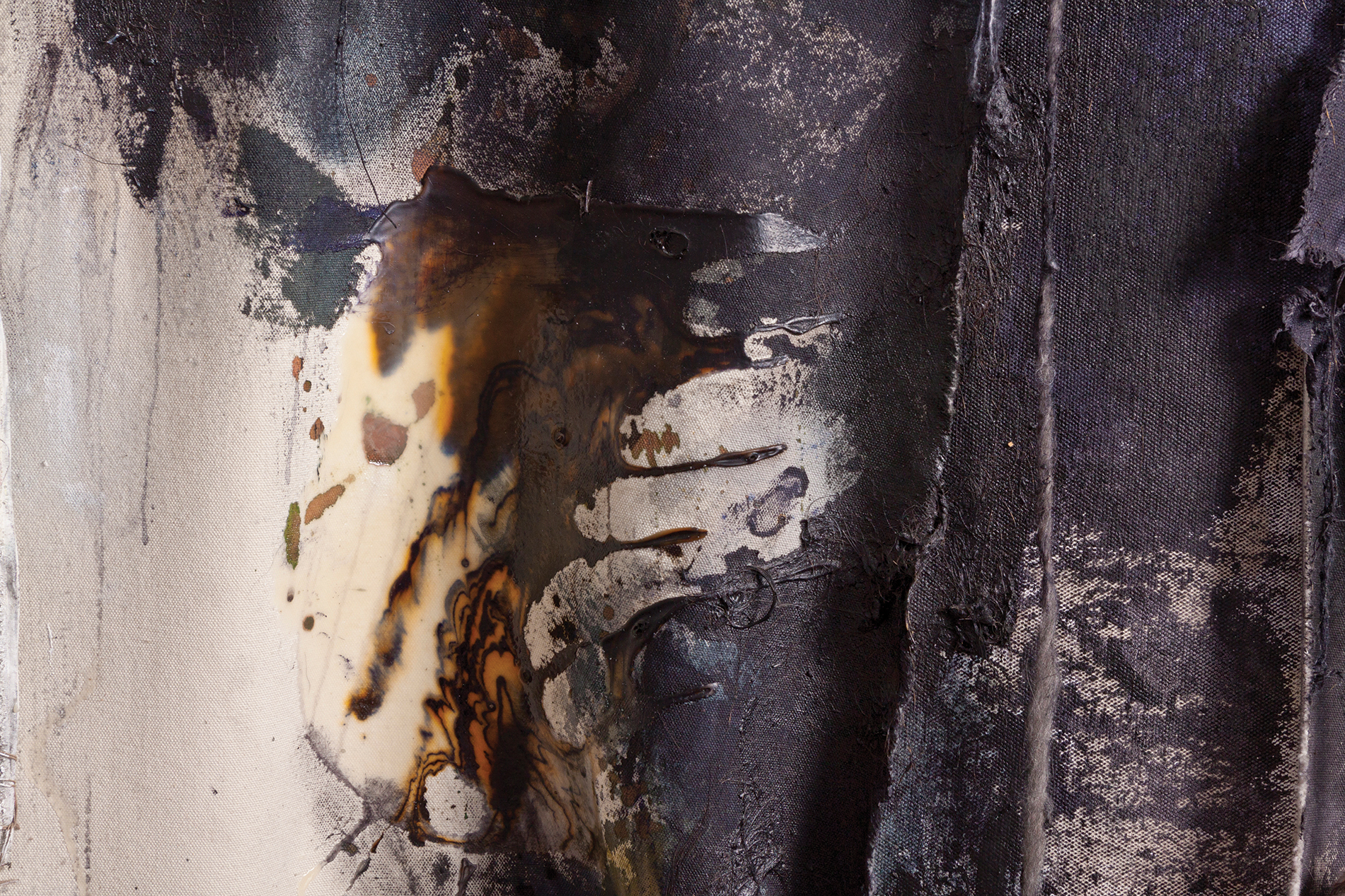I am excited to announce that my catalogue for the body of work Melancholia is in progress!
Fun in Les Hammond's studio
I am excited to announce that my catalogue for the body of work Melancholia is in progress!

Fun in Les Hammond's studio
In this work titled Deconstruction, I address the concept of being mindful about consumerism. I investigate the belief that second-hand clothing, considered to be waste, to still be wearable.
I aim to illustrate the outcome of used clothing that is dumped or discarded, by deconstructing jackets and using them as found materials in the studio, and then recycling them through the process of making, into a work of conceptual art.
In my interpretation, leather and fabric in different weights are deconstructed (torn, scraped and cut), intuitively selected and placed close together, inverted into dense layering and suspended from a steel construction on wheels resembling a clothing rail. The fine fabric of the lining and thick textural insulation, contrasted with the leather are exposed in many areas, to evoke a sense of the inner private world of the consumer. If the physical weight of ‘clothing’ on the rail becomes too heavy, the seemingly sturdy steel construction could snap, symbolising the fragility of the consumer that can so easily become obsessive with consumerism, which is more often about filling the emotional emptiness of the buyer.
This three-dimensional work represents how it mentally affects the way we act, think and feel, and the impact that waste has on the environment.
By rethinking consumerism, it opens up the possibilities of a new trend, therefore creating a market and need for second hand clothing as wearable or conceptual art.


Artist Fabian Saptouw (2015) writes that labour intensive work seems mundane and repetitive but has a goal and purpose in mind. This awareness of the artist’s labour is presented in my work to articulate the fact that the process of making the work is part and parcel of that artwork. He notes that “there is an intensity in the crafting process that should not be undervalued, nor negated using terms like ‘obsessive’ or ‘absurd’.” He states that “regarding labour as ‘obsessive’ is problematic because it discounts that labour as a compulsion as opposed to an action taken with specific intent.”
Saptouw, F. 2015. Contemporary Materialities. International Science Index, 17(7): 1185-1195.


In my work, the layering of recycled paintings, found canvasses and offcuts transforms a seemingly two-dimensional surface into a three-dimensional form or painting. Layering not only occupies physical space but also ‘fills emotional gaps’ to add conceptual meaning to the work. Hidden layers appear and reveal themselves in between other layers. This intuitive process of layering reveals a secretive space of ‘hiding’ in between the layers; it challenges the viewer to look and find deeper meaning, and thereby relates to the mysterious, deep nature of the temperament.

Historically, melancholia has been associated with artists for their propensity to dwell pensively on the world around them. Printmaker Albrecht Dürer is an apt example of an historical artist who portrayed the melancholic state of being, as epitomised in his engraving titled Melancholia (1514). The work is an illustration of a figure in a melancholic state that, drawing on Hippocrates, was said to ‘form’ in the body by black bile and yellow phlegm. This figurative portrayal of the temperament is imbued with what Kristeva (1989) terms “downheartedness.” The figure’s gaze speaks of deep sadness and a longing for understanding, emotional states that have been used to describe melancholia, which is elusive to define and is often confused with depression.
Post-critical thinker and psychoanalytical theorist Jacques Lacan (1992) speaks about this melancholic state as a constant feeling of something lost and unreachable but melancholia, often linked to the colour black and to darkness, should not be mistaken for depression.
In my interpretation, the concept of melancholia calls for the dense layering of canvas, in different weights, placed close together and bound by a mixture of glue and textural substances (swept up hair, broken feathers, dust, ash, found materials and ‘muck’, mixed with glue and paint). The materiality of this body of work hinges on the intuitive selection of mainly found materials that, through their abject qualities, embody a sense of melancholia.
Kristeva, J. 1989. Black Sun: Depression and Melancholy. Translated by Leon Roudiez. New York: Columbia University Press.
Lacan, J. 1992. The Four Fundamental Concepts of Psychoanalysis. New York: W.W. Nortan & Company.
Detail of surfaces and painterly forms:



